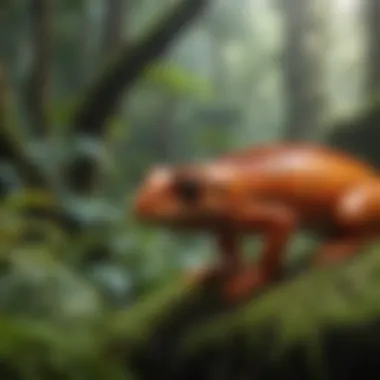Exploring Rainforests: Diversity of Plants and Animals


Intro
Rainforests represent diverse and intricate ecosystems filled with life. They are often called the lungs of our planet because they produce oxygen and absorb carbon dioxide. Rich in biodiversity, they house countless species of plants and animals, many of which are not found anywhere else on Earth. The vibrant colors and endless sounds from these environments inspire curiosity, and learning about them is both fascinating and crucial for understanding the importance of nature in our lives. This article explores the beauty of rainforest biodiversity, emphasizing the various roles of flora and fauna, while enlightening young minds about conservation efforts necessary to protect these irreplaceable habitats.
Nature Topic Overview
Rainforests cover about 6% of the global land area but contain more than half of the world’s plant and animal species. The dense trees in these areas provide a unique habitat. The thick greenery creates layers that support different life forms. Generally, they are divided into three main layers: the emergent layer, canopy, and forest floor. Each layer plays a distinct role and contains a wide variety of species that depend on each other for survival.
Emergent Layer
The emergent layer is the tallest part of the forest. It consists of their tallest trees standing high above others. Here, birds of prey like eagles and treetop dwellers such as bats struggle for space among large leaves and flying insects.
Canopy Layer
Surrounded by lush green leaves, the canopy is often called the “jungle roof.” It is in this layer many animals live. Monkeys, sloths, and a variety of birds call this place home. They thrive amidst the abundant fruits and flowers.
Forest Floor
The forest floor is populated with many species of insects, reptiles, and mammals. This layer receives less sunlight, making it a cold and shaded area. Decaying plants create nutrients required for living organisms.
Overall, having such a variety of plants and animals is crucial for maintaining ecological balance. The interdependencies create a complex web of life that supports the entire ecosystem.
Fun Facts and Trivia
Learning about rainforests can be fun! Here are some interesting facts:
- The Amazon rainforest produces about 20% of the world’s oxygen.
- There are approximately 30 million species of insects living in rainforests.
- Some rainforests will never see snow, part of why they remain so warm year-round.
- The largest rainforest is the Amazon, covering parts of Brazil, Peru, Colombia, and other countries.
To strengthen learning, incorporating visuals like pictures of specific animals or plants popular in rainforests can be beneficial. Interactive elements such as short quizzes about important facts might keep the young audience engaged in the subject.
Wildlife Explorations
Rainforests are teeming with life. There are beings both large and small, each with unique adaptations for survival.
- Harpy Eagle: This eagle has long claws and powerful wings. It lodges high in trees to spot its next meal, often monkeys and sloths.
- Red-eyed Tree Frog: With its vibrant green body and brilliant red eyes, this amphibian is a sight to behold! They grasp leaves and use their strong limbs to leap effectively among trees.
- Orchids: Multifaceted and iconic, orchids utilize bees and moths for pollination, showcasing an intricate relationship between plant and pollinator.
Understanding the ecosystems is as relevant as knowing individual species. This knowledge sheds light on how each being contributes to the health of its habitat. Simple puzzles about matching animals to their habitats would augment a child's interest in exploring biodiversity.
Environmental Awareness
Concerns regarding deforestation and climate change motivate conservation efforts. Rainforests drastically impact weather patterns, which is why their protection is so important.
Children can become involved in conservation efforts:
- Participate in tree planting programs.
- Learn about animals native to their region and their roles in their ecosystems.
- Share facts with friends about rainforests to spread awareness.
These tiny yet impactful actions can collectively drive greater change and help protect rainforest biodiversity.
DIY Nature Activities
Becoming a part of nature can be exciting. Outdoor adventures might uncover unexpected treasures. Here are some suggestions:
- Nature Journaling: Children can create a nature journal at home noting different wildlife in their area or during hikes. They can draw objects, describe sites, or write down fun facts.
- Craft Projects: Using leaves or flowers, children can create collages or paintings as seen in rainforest habitats.
- Scavenger Hunts: Organizing a scavenger hunt focused on flora and fauna provides a fun way to learn while experiencing the outdoors.
These simple engagements entwine children with nature, making learning enjoyable and approachable.
The lush biodiversity in rainforests exemplifies nature's brilliance and intricacy, while pressing the need for conservation as humanity progresses.
Prolusion to Rainforests
Rainforests are critical ecosystems that showcase vast diversity in flora and fauna. This section aims to highlight the complexity of rainforests, explaining their structure and significance. The unique conditions found in these environments support numerous life forms. This article delves deeper into these realms to illustrate that importance.
What Are Rainforests?
Rainforests are dense forest areas characterized by high rainfall, mostly occurring in tropical climates. They can be broadly categorized into two distinct types: tropical rainforests and temperate rainforests. Tropical rainforests, found near the equator, receive at least 2000 mm of rain annually, which supports lush vegetation and a broad array of species. While less common, temperate rainforests exist in cooler coastal regions, supporting different plant and animal life.


Features of rainforests include:
- High biodiversity: These environments host an incredible variety of species, like trees, plants, insects, birds, and mammals. Some estimates suggest that over 50% of the world’s terrestrial species reside in rainforests.
- Layered structure: Rainforests have distinct layers including the emergent layer, canopy layer, understory layer, and forest floor. Each layer has unique properties and is home to various organisms, which contributes to their overall biodiversity.
- Climate regulation: Rainforests play a crucial role in regulating local and global climates by influencing weather patterns and carbon storage, making them vital in combating climate change.
Importance of Rainforests
Rainforests serve as essential pillars of our planet, and their role cannot be overstated. Among their many contributions:
- Biodiversity Preservation: As mentioned, the variety of species in rainforests is extraordinary. The genetic pool from these organisms is a valuable resource for medicine, agriculture, and science.
- Climate Regulation: Rainforests absorb carbon dioxide, mitigating the effects of climate change. They regulate rainfall patterns and influence temperatures globally.
- Cultural Significance: Many indigenous bands that live in or near rainforests rely on them for food, shelter, and cultural identity. Loss of these forests equates to loss of their heritage.
- Economic Resources: Rainforests provide a wealth of resources, from timber and rubber to fruits and nuts. These products contribute to economies globally.
In summary, understanding what rainforests are and their importance is vital to approaching the topic of biodiversity. With this background, we can explore the specific plants and animals that inhabit these remarkable ecosystems.
Plants in the Rainforest
Plants in rainforests offer essential benefits for the ecosystem, including the habitats they create and the resources they provide. The types of rain forest plants vary widely, each contributing to the rainforest's overall health and survival. In addition, understanding these plants helps us appreciate our natural world and encourages conservation practices to protect these rich ecosystems.
Types of Rainforest Plants
Trees
Trees are a dominant feature of rainforests. They provide shelter and food for numerous species. One key characteristic of trees in this area is their height. Taller trees capture sunlight above the dense canopy. The shade they produce plays an essential role in maintaining the temperature of the rainforest below.
A unique feature of many rainforest trees is their broad leaves. This allows them to absorb as much sunlight as possible. While this makes them vital for energy production, the large surface area of the leaves can cause water loss. However, trees often develop adaptations, like waxy coatings, to minimize this loss.
Vines
Vines spiral around trees to seek sunlight as they grow upwards. They hardly produce their own leaves. This is a specific adaptation for survival in the shaded forest. A key characteristic of vines is their flexibility, allowing them to navigate gaps between tree trunks.
Their unique ability means they can cover large areas quickly. Yet, this can sometimes overwhelm the trees they attach to, competing for nutrients and light. Vines show the complexity and balance of plant relationships within the rainforest.
Ferns
Ferns thrive in the moist conditions of rainforests. They are not flowering plants but serve an important role in the ecosystem. A notable characteristic of ferns is their spores, which are different from seeds. Spores can allow ferns to reproduce in less favorable conditions.
Ferns often grow in layers. They add to the different levels of the rainforest. This structure creates habitats for many small animais. Although considered less popular than flowering plants, ferns are crucial to these intricate ecosystems.
Orchids
Orchids are colorful and diverse members of rainforest flora. They do well in many types of trees, taking advantage of their host without harming them. A distinctive feature of orchids is their unique shapes and sizes, which help them attract specific pollinators like bees and butterflies.
However, orchids can also be quite sensitive to changes in their environments. Any disruption to their habitat affects their survival and that of the connected species. Their intricate relationships with insects underline the complex dynamics within the rainforest ecosystem.
Adaptations for Survival
Plants in rainforests exhibit remarkable adaptations to survive. Combatting competition for light is vital. For instance, some plants develop climbing skills, while others grow large leaves. These adaptations enable them to meet the demands of their habitat.
Plenty of rain contributes significantly to plant growth, necessitating creatures to control slow nutrient absorption. This creates a unique balance between plants and the various organisms within the environment.
Role of Plants in Ecosystems
Plants provide various benefits within their ecosystems. They produce oxygen, absorb carbon dioxide, and serve as food and habitat for many animals. These interactions illustrate the interconnectedness of life in the rainforest.
Animals in the Rainforest
The diverse variety of animals found within rainforest ecosystems plays a vital role in maintaining the health and functionality of these regions. Animals interact with plants, offer pollination services, and manage the population balance among various species. Understanding the behavior and adaptations of rainforest animals helps us appreciate their impact on the ecosystem as a whole. This knowledge challenges us to focus on conservation efforts necessary to protect these beings and their habitats.
Common Rainforest Animals
Exploring the different classifications of animals in rainforests reveals their unique roles and significance.
Mammals
Mammals in the rainforest often possess certain traits that enable them to thrive in their environment. Many rainforest mammals, such as jaguars and capuchin monkeys, are crucial in controlling other animal populations, which is essential for maintaining balance in the ecosystem.
Key characteristics: They usually have adaptations like strong limbs or specialized diets that help them adapt to living among trees.


A significant feature is their ability to communicate through various sounds. By using vocalizations, they can alert others about predators or guide their young. However, their dependence on specific habitats may decrease their population numbers if deforestation occurs.
Birds
Birds play a crucial role in seed dispersal and pollination in rainforest environments. Species like toucans and macaws have striking beaks that allow them to feed on a range of fruits. This attribute supports their vital contribution in spreading seeds across long distances, facilitating forest regeneration.
Key characteristic: Most rainforest birds are colorful and often use visual displays during mating seasons.
Birds also have unique abilities to perch on tree branches, giving them a wide vantage point to scan for both food and threats. Their niche as pollinators makes them essential collaborators in the survival of various plants, although they face hassle from habitat loss.
Reptiles
Reptile species within rainforests contribute to the ecosystem by controlling pest populations and acting as both predator and prey. Examples like emerald tree boas and iguanas exemplify behaviors crucial for integration within the food chain.
Key characteristic: Many reptiles can adapt their hunting methods with varying strategies depending on available food sources.
The ability to remain camouflaged in dense vegetation gives these creatures an advantage, both for self-preservation and as predators. Their unique way of moving slowly and conservatively also conserves energy in their humid habitats.
Insects
Insects represent the largest portion of animal life in rainforests, engaging in essential roles such as decomposition and pollination. Orders like ants, beetles, and butterflies fulfill tasks that nourish both plant and animal life.
Key characteristic: Insects possess extraordinary reproductive rates, enabling communities to replenish rapidly after environmental disturbances.
The unique way insects communicate through pheromones or optimize their hunting skills aids survival within their ecosystems. Nonetheless, issues like pesticide use can threaten insect populations, which is alarming given their extensive contributions.
Unique Adaptations of Rainforest Animals
Many animals in rainforests showcase extraordinary adaptations tailored to the humidity, temperature, and competition found in their surroundings. These adaptations enhance their mating, foraging, and protective strategies, often involving changes in physical form or behavior.
For example, sloths exhibit slow movement to conserve energy and remain hidden from predators. Similarly, poison dart frogs display bright colors signaling to potential threats about their poisonous nature.
Understanding how these adaptations evolved connects us closer to the intricate web of interactions in rainforest ecosystems.
Predators and Prey
The dynamic between predators and prey showcases the delicate balance within rainforest ecosystems. Top predators, whether big cats or birds of prey, rely on smaller animals for survival. This interaction ensures the health of their populations.
Such relationships illustrate the complexity of food webs, where each species’ role and existence displays the interrelated nature of life in rainforests. Thus, witnessing this balance reminds us of the potential devastation if one component becomes rare.
Animals in rainforests play crucial roles in maintaining ecosystem stability, highlighting their importance for conservation efforts.
Interactions Between Plants and Animals
Understanding how plants and animals interact in rainforests is essential. This connection supports the entire ecosystem. Plants and animals depend on each other for survival. Through these interactions, they form complex relationships that enhance biodiversity. Each species plays a role that can affect others. For kids exploring nature, this shows how every creature is vital. Such awareness leads to a sense of responsibility to protect these habitats.
Mutualism
Mutualism is a key interaction where both plants and animals benefit. Many plants rely on animals for pollination. A common example is the flower known as a hibiscus and the bees that visit them. The plant offers nectar, food for the bee. The bee gathers pollen while helping the plant to reproduce. Without such animals, these plants would struggle to produce seeds and grow new individuals.
Another example is the relationship between fig trees and certain wasp species. The fig tree provides a safe space for wasps to lay eggs inside its flowers. In return, the wasps help pollinate these trees. This connection shows the balance necessary for both species to thrive.
Such interactions promote accessibility to resources. They can lead to greater genetic diversity. Healthier populations lead to a more stable ecosystem, which equally has good consequences for human life when we connect back to nature.
Food Chains and Food Webs
Food chains illustrate how energy moves from one organism to another. For instance, in a rainforest, plant leaves are eaten by insects. Then small animals might eat those insects. Larger mammals or birds can be the final consumers, eating those creatures.
Food webs expand on this basic idea. Consider all the possible paths of energy flow in the ecosystem. Let's look at some elements:
- Primary Producers: Plants create energy from sunlight.
- Primary Consumers: Herbivores consume those plants.
- Secondary Consumers: Snakes or birds that eat herbivores.
In a comprehensive food web, they create connections based on these interactions. It demonstrates how species depend on each other, meaning the well-being of one often links closely to another. This delicate balance underlines the importance of each element in its habitat.
Conservation tip: Maintaining these connections helps preserve cause and effect within the ecosystem. If one species fades, the effects will ripple through the entire forest.


Recognizing these dynamics is a foundation for understanding why biodiversity matters. By soaking in these examples, readers can appreciate that they hold the power to encourage conservation. Only then can generations foster a connection to the natural world that surrounds them.
Conservation of Rainforest Ecosystems
Rainforests are more than just dense forests filled with trees. They are thriving ecosystems that support a vast array of plant and animal species. The conservation of these ecosystems is crucial for several reasons. Firstly, rainforests play a significant role in regulating the Earth's climate by absorbing carbon dioxide and producing oxygen. This ability helps in mitigating climate change and supporting a healthy environment for all living beings.
Furthermore, rainforests are essential for maintaining biodiversity. They are home to about half of the world's plant and animal species, many of which cannot be found elsewhere. Protecting these ecosystems safeguards not only these organisms but also the genetic diversity they provide, which can have unpredicted benefits for science and medicine.
Another important aspect of rainforest conservation is the ecosystem services they offer to human populations. These services include clean water, fertile soil, and food resources. Protecting rainforests supports the livelihoods of millions of people, particularly indigenous communities that rely on these forests for their survival.
Threats to Rainforests
Despite their importance, rainforests face several threats. One major threat is deforestation, largely driven by agriculture, logging, and urban development. The expansion of farmland contributes significantly to forest loss, killing off the diverse flora and fauna that depend on these habitats. Additionally, illegal logging results in the degradation of these lush environments, further threatening their existence.
Another worrying factor is climate change. Rising temperatures and changing precipitation patterns are affecting rainforest habitats. Species that once thrived in particular climates may find it hard to survive in new conditions, leading to declines in their populations.
Moreover, mining activities destroy large areas of forest land, polluting soil and water sources. This puts pressure on already struggling ecosystems. Ultimately, human-induced changes become factors that drive many species toward extinction.
"Protecting our rainforests is not just an option, it is an obligation for future generations."
Conservation Efforts
Addressing the challenges facing rainforests requires concerted conservation efforts. Numerous organizations around the globe focus on increasing awareness about the importance of rainforests. They help target the key threats, pushing for policies to ban illegal logging and mining. Governments are urged to establish protected areas where these ecosystems can flourish without human disturbances.
Reforestation is another essential technique used in these efforts. Planting trees that are native to the region helps redefine ecosystems that were lost due to deforestation. The process helps rebuild habitats for numerous species, ensuring that they continue to thrive.
Local Community Involvement
Connecting with local communities is vital. When communities benefit directly from rainforest conservation, they become active participants in protecting their environment. Education plays a key role here. Teaching people about the importance of rainforests helps future generations understand the need for their protection.
The Future of Rainforests
Rainforests are essential ecosystems that support an array of plant and animal life. Their future depends heavily on our decisions today. Protecting these environments is crucial for maintaining biodiversity and combating climate change. As awareness of the challenges faced by these habitats grows, it's important to consider ways to improve their chances of survival.
Importance of Reforestation
Reforestation is the process of planting trees in areas where forests have been cut down or degraded. This practice is vital for several reasons.
- Biodiversity Enhancement: By restoring forest areas, we create habitats for countless species. This includes birds, insects, and mammals, allowing them to thrive once more.
- Carbon Sequestration: Trees absorb carbon dioxide from the atmosphere, helping to mitigate climate change. Acknowledging climate concerns promotes reforestation.
- Soil Conservation: Trees support healthy soil by preventing erosion. Their roots hold the ground in place and help to maintain watershed health.
- Community Benefits: Areas that embrace reforestation can see economic gains. Both local people and wildlife benefit from healthier ecosystems.
- Cultural Value: Forest ecosystems hold significance in many cultures. They can provide opportunities to learn while preserving tradition.
Investing in tree-planting initiatives is essential. Organizations promoting reforestation make a significant impact through various programs in vulnerable areas.
Community Involvement in Conservation
Communities play an essential role in rainforest conservation. Understanding how locals engage promotes sustainability. Participation empowers individuals and groups to safeguard their environment.
- Education and Awareness: Awareness programs teach individuals about local ecosystems. Knowledge can guide decision-making on conservation efforts.
- Participatory Monitoring: Involving community members in efforts to track atmospheric changes and wildlife populations allows for effective use of local knowledge.
- Sustainable Practices: Indigenous rites often involve using resources responsibly. This understanding is crucial in ensuring forest health and performance.
- Collaboration with NGOs: Local people work with organizations. This strengthens conservation effectiveness, as non-profits often have the funding and resources needed to problem-solve.
- Involvement in Reforestation Projects: Citizens can actively participate in tree planting initiatives, helping to restore forest areas and teaching others about the benefits.
To be effective in safeguarding rainforests, local expertise and engagement must be prioritized. Working in harmony boosts the preservation process and leads to sustainable outcomes.
Preserving our rainforests requires collective effort. Together, communities can make a significant difference.
In summary, addressing the future of rainforests includes understanding the significance of reforestation. Furthermore, community involvement forms the backbone of all conservation efforts. Awareness and action can ensure we protect the rainforests for generations to come.
Ending
The conclusions we draw from the study of rainforest biodiversity show us the unique and complex interrelationships among various organisms. Understanding how plants and animals fit into their ecosystem emphasizes their importance. Rainforests serve as essential habitats for innumerable species, which have adapted specifically to their environment. The connection between plants and animals creates a balance that supports life. Conservation of these areas is therefore critical, not just for the organisms residing there but for the health of the planet as well.
Final Thoughts on Biodiversity
Biodiversity in rainforests is not just about numbers. It represents a wide spectrum of life that relies on intricate dependencies. Diverse genetics in plants and animals enable them to adapt and survive. For instance,
- Trees can vary greatly, which helps support different animal species.
- Certain insects are key pollinators for plants, while numerous birds rely on those plants for food.
Much of our world's biodiversity is housed within these ecosystems. The threats to rainforests, such as deforestation and climate change, put this rich diversity at risk.
Conservation efforts, therefore, go beyond saving trees; they are about securing the future for generations to come.
Focusing on how to protect vital ecosystems will benefit not just humans but the entire planet. Legal protections, secure habitats, and community engagement form key parts of effective conservation strategies.
Further reading on this topic can provide valuable insights and strengthen our understanding of the urgent need for action to protect these irreplaceable environments. More information can be found on sites like Wikipedia and Britannica.







